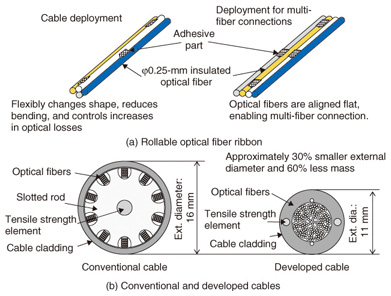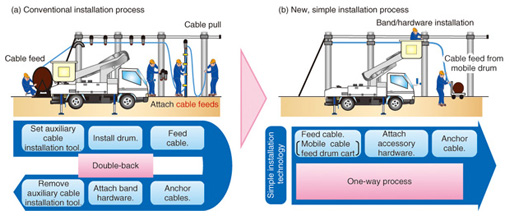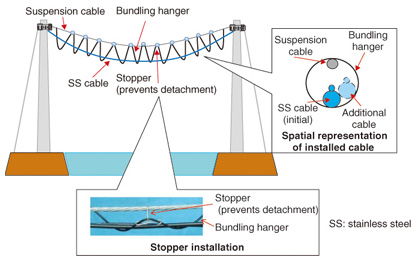 |
|
|
|
|
|
Feature Articles: NTT Tsukuba Forum 2013 Workshop Lectures Vol. 12, No. 3, pp. 44–47, Mar. 2014. https://doi.org/10.53829/ntr201403fa7  Trends in Optical Access Network TechnologiesAbstractThe Second Promotional Project at NTT Access Network Service Systems Laboratories is focused on research and development of practical implementations of media network technologies. This article introduces the initiatives of the Second Promotional Project and the latest optical access network technologies. This Feature Article is based on a workshop presentation at the Tsukuba Forum 2013, held on October 18, 2013. Keywords: optical access network, trend, implementation 1. Initiatives of the Second Promotional ProjectThe researchers at NTT Access Network Service Systems Laboratories are engaged in two main types of work. One team conducts core technical research on networks, and the other takes each of the technologies resulting from this network research and performs the research and development (R&D) required to implement them in the field, such as providing field support and establishing specific manufacturing technologies that are needed in the field. The Second Promotional Project deals with the latter. The main objective of the project is to implement technologies developed by the core research team in the field and to provide support for R&D and technical implementations carried out in the field. R&D at NTT Access Network Service Systems Laboratories spans various technical fields and is divided into four categories according to field: optical access network technology, wireless access technology, infrastructure technology, and media network technology. The Second Promotional Project involves media network technology, with a particular focus on optical access networks, and also involves conducting R&D to improve the economy, quality, and stability of established technologies so they can be used in the field. Additionally, all installation configuration equipment is being developed in this project. This includes the equipment in NTT buildings, intra-office wiring cables, test equipment such as optical testing modules, underground and aerial cables and closures, drop cables, multi-dwelling wiring, connectors for optical network units, and indoor cables. Examples of components that have been developed recently include an intra-office bending-loss insensitive (BI) cable. This BI cable uses hole-assisted fiber (HAF) technology in order to control the optical loss that occurs when the fiber is curved or bent compared with conventional cable. Underground cable sections were conventionally operated by attaching an underground optical cable closure having both optical cable distribution and drop functions at each communication cable box or hand hole, but this led to problems including increased costs and operational difficulties. Therefore, we developed a new single-fiber count underground cable and separate closures for underground cable distribution points and drops in order to improve the operability of underground cable installations. The decision to hold the Olympic Games in Tokyo has accelerated plans to move facilities underground, so we expect these technologies to be widely used. We have also built the highest-density aerial optical cables in the world, which are described in detail below. The aerial closures are also designed for better operability and economy than earlier closures. An example is break-in technology. Conventionally, it was not possible to re-use the lower part of a cable if the fiber in an aerial section was partially cut. However, we developed a break-in pigtail to connect the upper and lower parts, and with it, we are now able to effectively use optical fiber that could not previously be used. In collective housing such as multi-dwellings, the space for installing splitters, cabinets, and other equipment is usually limited, so we developed the E-cabinet series that can be installed in restricted spaces with varying shapes. Intra-premises wiring generally involves using a conduit to service each room. However, copper cables occupy a lot of space in the conduit, which makes multi-cable installation difficult. Therefore, we used small-diameter, low-friction, indoor optical fiber, which enabled installation in existing conduits that only have a small amount of space available. Also, by giving the cable some rigidity, we were able to push it directly into the conduit without requiring the use of a wire-pulling tool. This greatly improved the deployment. However, when there are no usable conduits, even in single dwellings, holes must be drilled in external walls, and this can be difficult in terms of obtaining agreement from the owner or because of the building structure. Thus, we developed a new wiring method that does not require holes to be drilled in external walls. Instead, it uses an indoor optical cable for restricted spaces that is able to pass through narrow gaps in doorways or window sashes. HAF technology was used to implement this cabling. 2. Recently developed access network technologies2.1 Very-small-diameter high-density optical fiber cablesWe have developed optical cables with the highest density in the world. The 200-fiber count cable is thin and lightweight, with an external diameter 30% smaller than conventional cables, and a weight 60% lighter. The core technology used to achieve these cables is the rollable optical fiber ribbon shown in Fig. 1. Earlier versions of optical fiber ribbon consisted of four parallel fibers insulated as a bundle, which enabled multi-fiber connections. However, when these were housed at high density, the optical fibers tended to bend significantly, which increased the optical losses. Consequently, cables were configured with a slotted rod to protect the fibers. The rollable optical fiber ribbon has four parallel optical fibers that are intermittently connected. Thus, the bending can be controlled, and they can still be connected as a bundle, as with conventional optical fiber ribbon.
Further, various economic benefits are gained by reducing the diameter and weight; these include a reduction in the materials cost, which makes it possible to reduce the product price, reduced deployment cost, because pulling tools are not required, and less need for additional conduit in sections where the conduit is pushed up above ground. 2.2 Optical access facilities configuration technology for rural areasIn developing the optical services for NTT EAST and NTT WEST, optical equipment was deployed throughout the country. Facilities were already adequate in most urban areas, so development of rural areas was planned for the future. The environment in rural areas is different from that in urban areas in terms of the distances from NTT buildings to customer premises and the customer density (as well as river and valley crossings). Therefore, we developed easy installation technology suitable for rural environments and long-span aerial installation technologies. In the past, installation was a round-trip process that consisted of first fixing a cable drum, then pulling out the cable through a cable pulley, and then, after terminating the end of the cable, backtracking along the route to complete the work of removing the lift and cable pulley and other necessary tasks. By contrast, the newly developed easy deployment method involves loading the cable on a portable drum and feeding out the cable as the cart moves along. The cable is raised onto the pole with each span, which makes a lot of the work and the need to double back unnecessary, so the job can be completed in one trip and with fewer workers (Fig. 2). To use this new and easier deployment method for trunk routes in rural areas, which require a 24-fiber count cable, the diameter and weight of the cables were reduced further still. This reduction was achieved by developing a 24-fiber count cable with the same dimensions as a conventional 8-fiber count flexible distribution cable. It is light enough to be moved on a mobile cart, and a single segment of the required length (500 m) can be fed out from the portable drum. Also, to handle distances over 500 m, we developed joints and spacers that enable multi-fiber connections to be made easily by having connector components attached to the cable at the factory. We also achieved easier installation for routes branching from the main line by using an 8-fiber count cable that is similar to an ordinary drop cable.
Long-span aerial installations on segments longer than the 60-m span between utility poles that is characteristic of rural areas has conventionally required special construction techniques for aerial work. However, we have developed new construction technology that does not require special techniques, tools, or devices. The new construction procedure involves building the aerial section with a suspension wire to which bundling wires are attached. Then, cables and a draw wire for future expansion are installed in the hangers. The bundling hangers are equipped with stoppers that prevent them from detaching and that prevent the cable from rotating or falling off (Fig. 3). This technology enables cables to be changed or added quickly. It should also help with rapid recovery when dealing with a disaster.
3. Future developmentsThe work to reinforce the optical access network providing the infrastructure for broadband services will continue, and future issues include how to maintain service quality for over 20 million customers while providing and operating new services, how to carry out the large amount of activation and withdrawal work efficiently, how to operate with both copper and optical services coexisting, and to do all of this without neglecting safety initiatives, which are the highest priority. We will continue to deal with on-site demand and make full use of results from other labs and technology from our development partners, and to develop products that are useful in the field and that can be widely used in Japan and in other countries as well. ProfileCareer highlightsProject Manager, Second Promotion Project, NTT Access Network Service Systems Laboratories. Shigeki Sako received the B.E. and M.E. degrees in civil engineering from Tokushima University in 1988 and 1990, respectively. He joined NTT in 1990 and engaged in network plant planning and maintenance. He moved to NTT Access Network Service Systems Laboratories in 2011 and was responsible for the development of optical access network operation support systems. He has held his present position since 2013. |
|











